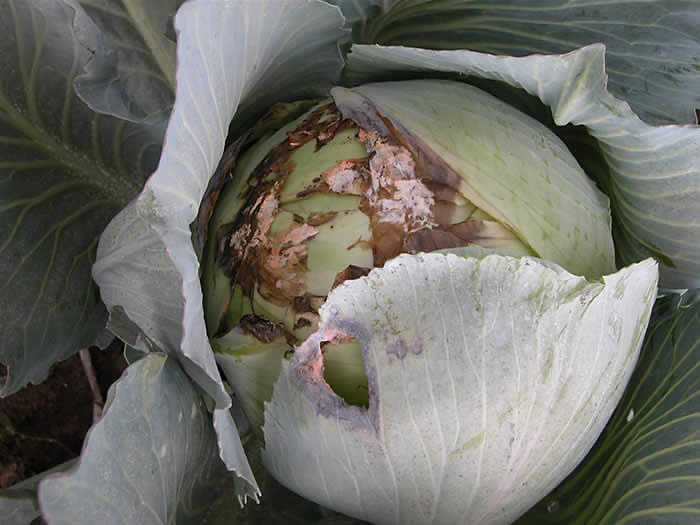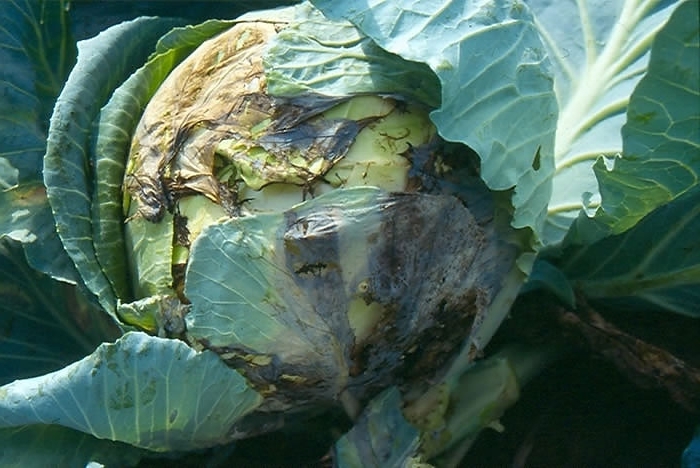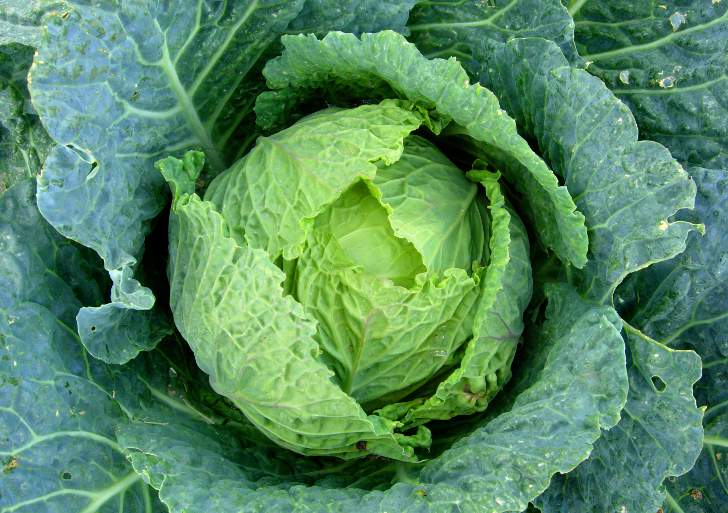The most dangerous and common cabbage diseases
Content
White rot
One of the most common cabbage diseases is white rot. The fungus Sclerotinia sclerotiorum is considered to be its causative agent. Symptoms of the disease include:
- mucous membranes that appear on the outer leaves;
- the appearance between the leaves and on the head of white cotton-like mycelium;
- then the fungus forms black sclerotia in large numbers. Their size ranges from 0.1 to 3 cm;
- heads of cabbage infected with rot are not stored - they quickly rot. In this case, neighboring vegetables are infected.
The disease itself is characterized by a focal character. The above symptoms of the disease of white cabbage appear before harvesting. Such plants cannot be used in folk medicine, in particular, for the treatment of gallstone disease.
To combat white rot, the following agrotechnical methods are used:
- preservation during harvesting on heads of cabbage about 2-3 cover sheets;
- prevention of cabbage damage during picking;
- timely cleaning;
- proper preparation for storage;
- disinfection and cleaning of storage facilities;
- observance of the correct storage regime. The optimum temperature regime is (0-1 ° C);
- observance of crop rotation with a period of 6-7 years.
If these recommendations are followed, the cabbage will be healthy and suitable for medicinal purposes (the same gallstone disease, for example) or regular nutrition.
Gray rot
Another common cabbage disease is gray rot. Its causative agent is also a fungus belonging to the facultative parasites. It infects weakened or necrotic plant tissues.
Symptoms of gray rot include:
- the appearance of mucous bacteriosis;
- covering the heads of cabbage with a brown fluffy bloom, which contains the spores of the pathogen;
- with severe infection, rotting of the vegetable occurs;
- in the last phases of the development of the disease, black sclerotia appear on the head of cabbage.
The methods of struggle involve manipulations in many ways similar, which are carried out to prevent white rot:
- timely harvest;
- prevention of damage to heads of cabbage;
- preservation during assembly of 2-3 covering leaves;
- storage of vegetables in optimal temperature and humidity conditions;
- disinfection and cleaning of storage facilities;
- rejection for storage of slightly frozen and damaged heads of cabbage.
In addition, it is recommended to use varieties that are resistant to this disease for sowing. The most popular varieties of white cabbage that are resistant to gray rot are Monarch and F1 Lezhky. Such varieties are not only used to treat gallstone disease, but also taste good.
Keela
Diseases of cabbage are varied. And another of their manifestations is Keel's disease. This disease is considered the most dangerous and widespread among the crops of white cabbage. Keela is as serious for cabbage as cancer is for potatoes. The causative agent of Keela is a fungus that infects the roots of the plant.
Keel's symptoms do not appear immediately after the vegetable is infected. Therefore, it is not possible to identify the disease at an early stage.Symptoms of this disease can only be detected by digging up the plant.
Keel's disease has the following clinical presentation:
- slight wilting of leaves;
- leaves may turn yellowish;
- heads of cabbage may be underdeveloped;
- bulges and growths appear on the roots. In the future, these growths begin to rot.
As you can see, Keela's symptoms are not pronounced and can be skipped if inattentive. Therefore, be careful, especially when treating gallstone disease with cabbage.
Keel's disease control measures include the following:
- destruction of affected plants;
- processing the land in places where affected vegetables grow with formalin or Bordeaux liquid;
- cultivation of soil with colloidal sulfur. At 1m2 there is a 5 g or 0.4% solution;
- thermal treatment of the soil. This means heating the soil with steam for 3 hours. The method is used to disinfect soil in greenhouses.
- culture turnover lasting 5-7 years;
- liming of the soil.
Video “Diseases of white cabbage and their treatment
Yellowness
Fusarium wilting of cabbage or its yellowness is another fairly common disease of this plant. The causative agent of yellowness is the fungus Fusarium oxysporum. It mainly affects early plant varieties. This is especially true for seedlings.
The main signs of yellow cabbage disease include:
- the appearance of a specific color of the leaves. They take on a yellow-green hue. The leaf can become this color only partially;
- loss of turgor by leaves;
- uneven development of the leaf plate;
- the lesion is localized on the head of cabbage;
- shedding of leaves until the head of cabbage is completely bare (with neglect of pathological processes).
If you make a cross-section of the head of cabbage and leaf stalks, you will see dark brown or light brown rings of vessels.
The list of control measures developed against fusarium wilting includes the following agrotechnical measures:
- destruction of plants;
- steaming or replacing soil;
- autumn soil disinfection. To do this, you must use a solution of copper sulfate. We prepare it at the rate of 10 liters of water 5 g of the drug.
When carrying out the above methods of struggle, your harvest will be suitable not only for purely gastronomic purposes, but also for the treatment of gallstone disease.
Mosaic
Mosaic on cabbage leaves is not uncommon. The causative agent of this disease is a virus that infects all currently known cabbage varieties.
The first symptoms of infection appear within a month after planting seedlings in open ground. The main symptom of this disease in white cabbage is the appearance of a specific mosaic pattern on the leaves.
In addition, the following symptoms of the course of the disease are possible:
- clarification of leaf veins;
- the appearance of a dark green border on them;
- the sheet becomes wrinkled and deformed;
- in rare cases, necrotic spots appear on the leaf plate;
- then there is the dying off and abscission of the affected leaves.
Fighting this ailment is useless. Therefore, if a mosaic is detected, all affected plants are subject to immediate destruction. Affected heads of cabbage should not be eaten, and even more so used to treat gallstone disease, even when the infected leaves are removed. Here, only preventive measures are possible, which include:
- weeding beds from weeds;
- treatment of plants with insecticides, since ticks and aphids are carriers of the virus;
- planting seedlings away from state farm fields.
Downy mildew
In addition to the above diseases of cabbage, another fairly common ailment is downy mildew or downy mildew. The causative agent of this disease is the mushroom Peronospora parasitica.
The symptomatic picture with downy mildew has the following manifestations:
- reddish-yellowish or gray-yellow blurred spots appear on the leaves.Loose mycelium is formed from below such spots;
- the mycelium looks like fork-branched conidiophores. They end in colorless oval conidia ranging in size from 22 to 20 microns;
- during one growing season, several generations of conidia are formed;
- at the end of the season, the formation of rounded yellow oospores is characteristic. It is because of them that secondary infection of plants occurs;
- the affected leaves turn yellow and fall off over time.
To combat peronosporosis, specialists have developed the following agrotechnical methods:
- maintaining in greenhouses optimal indicators for the development of seedlings;
- post-harvest harvesting of all plant residues;
- use for seedlings only healthy seeds that do not have external defects;
- before sowing, the soil is etched with planriz or TMTD;
- hydrothermal treatment of seeds. Here, it is assumed that the seeds are immersed in hot water for 20 minutes. Water temperature - about 50 ° С, no more. After that, the seeds should be quickly cooled for 2-3 minutes in cold water.
If the first symptoms appear on the seedlings, after planting it must be treated with specialized preparations designed to combat this particular disease.
In the treatment of gallstone disease, plants that have even minor signs of this ailment are by no means used.
Blackleg
The black leg of cabbage most often affects seedlings. It is considered a very dangerous disease. The group of pathogens includes various types of fungi.
Its characteristic features include the following manifestations:
- the affected part of the stem becomes watery;
- darkening (sometimes it can turn brown) with further decay of the lower part of the stem;
- thinning of the root collar and further darkening with the formation of a constriction;
- in the future, the death of the entire plant is possible.
In the active stage of the disease, neighboring plants are infected.
If infected seedlings are planted in the ground, then the plants will not take root well due to a weak root system and often stop developing or die.
For this disease, the following control measures have been developed:
- planting those varieties of cabbage that have a high resistance to this ailment. Such varieties include, for example, Kazachok, but the most affected varieties are Belorusskaya 455, Moskovskaya late 9 and Amager 611;
- disinfection of seeds before planting with biological preparations (Planriz, Baktofit, Fitolavin-300, Fitosporin) or chemical (Cumulus DF, Fundazol, TMTD). Chemicals in this situation will be more effective;
- fresh soil;
- frequent change of soil and its disinfection with chemicals.
As you can see, there are many diseases of cabbage. Therefore, knowledge of the first symptoms of the disease and methods of dealing with it will help to grow a high-quality and healthy crop that can help in the treatment of even gallstone disease.
Video "Tricks of growing cabbage"
How to protect your crop from diseases and pests, and what to do if a misfortune does happen? You will find some tricks for growing, caring for and treating cabbage in the video below.







